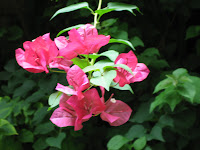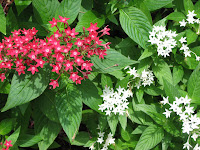Sunday, July 27, 2008
Sunday, January 13, 2008
Singapore Food
Mom's special

Clockwise:
1. Egg Tofu
2. 3. Popiah
4. Suan Pan Zi, made with Yam
5. Sea Cucumber
6. Almond Tofu
7. 8. Steam Boat with Hot Plate
9. Fried Spring Roll
Singapore Delights

1. Singapore Carrot Cake
2. Lor Mee
3. Mr. Bean Soya Milk
4. Malay Spicy Shrimp Fried Rice, the best fried rice I've ever had
5. Chicken with Seaweed
6. Singapore Hawkers Center, the place where real Singaporean eats
7. Red Tea Ice Cream with Pearls
8. 9. Mango Pudding with Pomelo and Coconut Milk, Wanting's favorite

1. White Muer Drink with Sweet Potato
2. Pulut Hitam, made with black glutinous rice
3. Coffee Pudding
4. Vegetarian Tuna Sandwich
5. Vegetarian Lasagna
6. Japanese Salad with Wasabi Mayo
7. 8. Black Sesame Ice Cream, Wanhui recommendation
9. Green Tea Ice Cream with Hot Dumpling and Red Beans

1. Singapore Fried Noodle, not the fake North American version
2. Laksa
3. Satay
4. Chwee Kueh
5. Soon Kueh
6. A Fried Banana Vendor
7. Longan Drink
8. Hokkien Prawn Noodle
9. Fried Oyster with Egg

1. Ice Cream on Bread
2. Ice Kachang
3. Tapioca Cake
4. 5. 6. 7. Tutu Kueh
8. Malay Fried Prawn Snack
9. Sticky Rice Snack Filled with Coconut Sugar

1. Mouth Filled with Curry Puff
2. Popular Curry Puff Vendor
3. Fried Squid Head
4. Curry Puff
5. Smart Alec, tasty custard bread from Bread Talk
6. Secret Recipe Marble Cheese Cake
7. 8. Sea Food Platter
9. Ba Chor Mee, minced meat noodle
Singapore Food Guide:
http://www.makantime.com/index.html
Clockwise:
1. Egg Tofu
2. 3. Popiah
4. Suan Pan Zi, made with Yam
5. Sea Cucumber
6. Almond Tofu
7. 8. Steam Boat with Hot Plate
9. Fried Spring Roll
Singapore Delights
1. Singapore Carrot Cake
2. Lor Mee
3. Mr. Bean Soya Milk
4. Malay Spicy Shrimp Fried Rice, the best fried rice I've ever had
5. Chicken with Seaweed
6. Singapore Hawkers Center, the place where real Singaporean eats
7. Red Tea Ice Cream with Pearls
8. 9. Mango Pudding with Pomelo and Coconut Milk, Wanting's favorite
1. White Muer Drink with Sweet Potato
2. Pulut Hitam, made with black glutinous rice
3. Coffee Pudding
4. Vegetarian Tuna Sandwich
5. Vegetarian Lasagna
6. Japanese Salad with Wasabi Mayo
7. 8. Black Sesame Ice Cream, Wanhui recommendation
9. Green Tea Ice Cream with Hot Dumpling and Red Beans
1. Singapore Fried Noodle, not the fake North American version
2. Laksa
3. Satay
4. Chwee Kueh
5. Soon Kueh
6. A Fried Banana Vendor
7. Longan Drink
8. Hokkien Prawn Noodle
9. Fried Oyster with Egg
1. Ice Cream on Bread
2. Ice Kachang
3. Tapioca Cake
4. 5. 6. 7. Tutu Kueh
8. Malay Fried Prawn Snack
9. Sticky Rice Snack Filled with Coconut Sugar
1. Mouth Filled with Curry Puff
2. Popular Curry Puff Vendor
3. Fried Squid Head
4. Curry Puff
5. Smart Alec, tasty custard bread from Bread Talk
6. Secret Recipe Marble Cheese Cake
7. 8. Sea Food Platter
9. Ba Chor Mee, minced meat noodle
Singapore Food Guide:
http://www.makantime.com/index.html
Singapore Trip
City View

Clockwise:
1. Parliament House
2.3.6. Old Supreme Court
4. Saint Andrew's Cathedral
5. An interesting building at Central Business District
7.9. Esplanade Theatres
8. Merlion
Family and friend

1. Teacher Wanhui's secrest recipe for making fruit tart
2. Ji Gu Ba Competition
3. H1 and W3
4. 5. 8. Family pictures
6. Members of Da Cheng Jiao
7. Napping at Botanic Garden
9. Lau Siblings
Singapore Botanic Garden

Samoan Fluff (Clockwise, 3&9), White Ginger (4), Pitcher Plant (5), Golden Shower (7) and Heritage Tree (8)
National Orchid Garden

Clockwise:
1. Parliament House
2.3.6. Old Supreme Court
4. Saint Andrew's Cathedral
5. An interesting building at Central Business District
7.9. Esplanade Theatres
8. Merlion
Family and friend
1. Teacher Wanhui's secrest recipe for making fruit tart
2. Ji Gu Ba Competition
3. H1 and W3
4. 5. 8. Family pictures
6. Members of Da Cheng Jiao
7. Napping at Botanic Garden
9. Lau Siblings
Singapore Botanic Garden
Samoan Fluff (Clockwise, 3&9), White Ginger (4), Pitcher Plant (5), Golden Shower (7) and Heritage Tree (8)
National Orchid Garden
Saturday, January 12, 2008
To Shun's father
Monday, July 16, 2007
Sunday, June 03, 2007
Monday, May 21, 2007
Canada Geese - by Shun
A beautiful day at Lake Crest.
There are three lakes within walking distance from home. We decided to take a relaxing walk on this beautiful Sunday. And to our surprise, not only us are enjoying the beautiful day, the Canada Geese and their goslings are out having fun too. We ask them if we could have their pictures and they happily obliged...








There are three lakes within walking distance from home. We decided to take a relaxing walk on this beautiful Sunday. And to our surprise, not only us are enjoying the beautiful day, the Canada Geese and their goslings are out having fun too. We ask them if we could have their pictures and they happily obliged...








Friday, May 18, 2007
Now I see why my aloe leaves turn brown!
 TAKING CARE OF "NATURE'S DRUGSTORE": ALOE VERA
TAKING CARE OF "NATURE'S DRUGSTORE": ALOE VERA From http://www.youth.net/kitchen/hypermail/0067.html
Size of Plant--it is often said incorrectly that a plant has to be three to four years old before it is potent enough to be used for healing. Actually, even a very young plant has considerable potency. However, the strength does increase with age and one should have at least one mature plant around the home. For this reason we encourage people to purchase as large an Aloe Vera as they have room for in the home. The plants usually grow very slowly in the house.
Indoors and Outdoors -- Aloe Vera turns brown in harsh sunlight so it should be kept in indirect light. It will freeze so it must be protected when danger of heavy frost exists. Other than that, it grows faster outside than inside, but most people grow Aloe Vera as an indoor, ornamental plant.
Watering -- Aloe Vera is a succulent. This means that it is in greater danger of overwatering than underwatering. It should be allowed to become fairly dry before watering. During the winter months, watering should be light, such as only a cup or two, since drying out will be slow. In the summer, the pot can be really soaked. Be sure there is a drainage hole in the pot since the roots will rot off when exposed to long periods of wet soil.
Repotting--Aloe Vera can stand being root-bound, so repotting is not necessary until the upper plant gets top-heavy. When a plant gets root-bound, it will send out more new shoots or pups. If these are not taken out for replanting when they are 3 to 4 inches high, they will suck the life from the mother plarlt, which will get bright green and spread its leaves horizontally rather than vertically. The plants will grow in any kind of soil but good drainage is essential. The pups should be repotted when large enough, watered well and not watered again for about 3 weeks, forcing new roots to seek water. The transplanted pup may turn grey or brown for a while, which is normal. New pups make wonderful presents.
SYMPTOMS OF POOR PLANT CARE
1. Leaves lie flat instead of upright: Usually caused by insufficient light. Although Aloe Vera turns brown in harsh sunlight, it does need a fair amount of light.
2. Leaves are thin and curled: Not being watered enough thus using up its own liquid.
3. Leaves brown: Too much direct Sunshine.
4. Very slow growth: Probable causes might be too alkaline water or soil, too damp too long, not enough lights too much fertilizer.
5. Disease or infestation: This is almost non-existent here in the temperate zone
USING AN ALOE VERA LEAF FOR EXTERNAL USE
What Leaf to Use? Always use the lowest leaves, the closest to the ground first. There are several reasons. first, the bottom leaves are older and larger, thus have more juice and greater potency. Also, since the plant grows from the center and the cut leaves do not grow hack, the plant will still retain its beauty and continued growth.
How To Cut A Leaf: After cutting off the portion of the leaf you want with a sharp knife trim the thorny edges from the severed portion, then slice the leaf across its width, like filleting a fish. Tlle inner. exposed surfaces will reveal the transparentt gooey gel which is ready to be applied directly to the afflicted area. Use it generously. It will be absorbed by the skin within several minutes.
How long Will A Leaf Last? If the gel is being applied over a large area like a sunburn, it may soon seem to be exhausted of gel by running dry. Tllis is only a surface appearance because the remaining gel is held captive in small elongated cells underneath which are still intact. After the gel from tlle first layer of ruptured cells has run dry, scratch the surface with a clean knife to rupttlre more cells releasing morew juice. This will lbe continued until there is nothing but green skin left. A partially used leaf can be wrapped in foil or saran wrap and refrigerated, where it will last for days.
Subscribe to:
Comments (Atom)




















